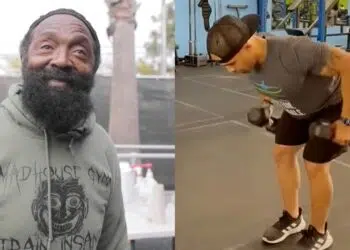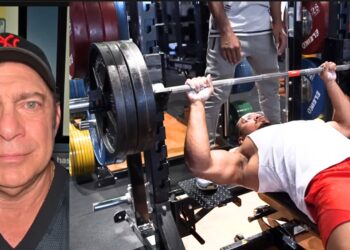Broadly speaking, most strength training exercises can be divided into two groups: isolation and compound. Isolation exercises involve a single joint, such as leg extensions, calf raises, and triceps pushdowns.
In contrast, compound exercises involve multiple joints and several muscle groups. Examples include squats, pull-ups, and power cleans.
When it comes to building strength and muscle mass, compound exercises are usually the quickest and most effective way to get the results you want. As a personal trainer with over 35 years of hands-on experience, I’ve helped numerous people transform their physiques with nothing more than compound exercises.
In this article, I reveal the 12 most potent compound exercises you can do.
Recent Updates: On July 23, 2024, Fitness Volt’s Content Strategist Tom Miller (CSCS) and Senior Editor Vidur Saini (American Council on Exercise-CPT) updated the article and added actionable expert tips throughout the piece to improve the reader experience. Level Up Your Fitness: Join our 💪 strong community in Fitness Volt Newsletter. Get daily inspiration, expert-backed workouts, nutrition tips, the latest in strength sports, and the support you need to reach your goals. Subscribe for free!
12 Best Compound Exercises
Add the following exercises to your arsenal:
- Squats
- Deadlifts
- Lunges
- Leg Presses
- Bench Press
- Standing Shoulder Press
- Bent-Over Rows
- Pull-Ups And Chin-Ups
- Power Cleans
- Burpees
- Kettlebell Swings
- Thrusters
Best Compound Movements for Lower Body Strength
If you are serious about getting as big and strong as possible, you need to work your legs. Here are the best lower-body compound exercises:
1. Squats
| Sets & Reps | 3 x 8-12 (Hypertrophy) or 5 x 3-5 (Strength) |
| Equipment Needed | Barbell, squat rack (optional: weight belt) |
| Target Muscles | Quadriceps, glutes, hamstrings, core |
Squats aren’t just one of the best lower body moves you can do; they can help you add muscle mass from head to toe. Squats are not only an excellent muscle builder, but they are also one of the best exercises for strength.
Squats are the first exercise in most powerlifting competitions and are also featured in strongman events. Whatever your fitness goal is, they will help you achieve it faster.
“Squats are the king of lower body exercises,” says Saini. They build not only leg strength and muscle but also increase overall body strength and athleticism.
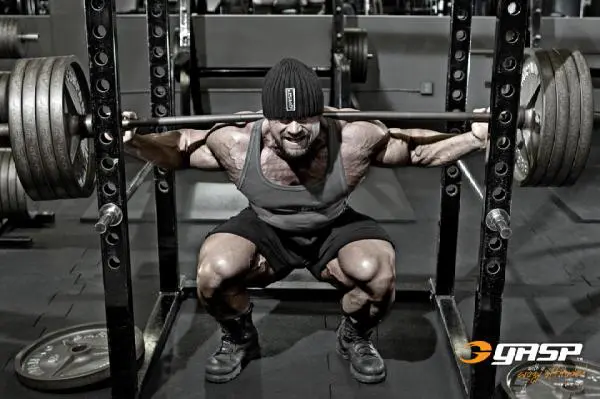
How to do it:
- Rack and hold a barbell across your upper back. It should rest on your traps and not across your neck. Step out, so your feet are roughly shoulder-width apart, toes turned slightly outward. Brace your abs, lift your chest, and look straight ahead.
- Push your hips back, bend your legs, and squat down until your thighs are roughly parallel to the floor. Do not allow your lower back to round.
- Stand fully upright and repeat.
Pro Tip: Think about spreading the floor with your feet as you drive upwards. This engages the external rotators of the hips, enhancing stability and power.
| Difficulty | Intermediate |
| Progression | Front squats, goblet squats with weight, overhead squats, single-leg squats |
| Regression | Box squats, assisted squats (with bands), wall sits |
2. Deadlifts
| Sets & Reps | 3 x 6-8 (Hypertrophy) or 5 x 1-3 (Strength) |
| Equipment Needed | Barbell, weight plates (optional: straps, belt) |
| Target Muscles | Hamstrings, glutes, erector spinae, traps |
Like squats, deadlifts also feature in powerlifting competitions. However, where squats tend to emphasize your quads, deadlifts emphasize your posterior chain more.
These are the muscles on the back of your body, including your glutes, hamstrings, and lower back. Deadlifts are also great upper back and lat exercises.
Saini explains that the deadlift is a fundamental movement pattern that mimics how we pick things up in everyday life. It’s among the best exercises for developing overall strength and power.
How to do it:
- Place a loaded barbell on the floor and stand with your toes beneath it, feet roughly hip-width apart. Squat down and grab the bar with an overhand or mixed grip.
- Straighten your arms, lower your hips, lift your chest, brace your abs, and look straight ahead. This is your starting position.
- Without rounding your lower back, drive your feet to the floor and stand up. Make sure your hips do not rise faster than your shoulders.
- Stand fully upright but do not lean back.
- Lower the weight back to the floor, allow it to settle for a second or two, reset your core, and repeat.
Pro Tip: Initiate the pull by engaging your lats and pulling the slack out of the bar. This creates tension throughout the body before the actual lift begins, leading to a more efficient pull.
| Difficulty | Advanced |
| Progression | Deficit deadlifts, Romanian deadlifts (RDLs), sumo deadlifts |
| Regression | Trap bar deadlifts, kettlebell deadlifts, good mornings |
3. Lunges
| Sets & Reps | 3 x 10-15 per leg (Hypertrophy) or 3 x 6-8 per leg (Strength) |
| Equipment Needed | Bodyweight (optional: dumbbells, barbell) |
| Target Muscles | Quadriceps, glutes, hamstrings |
Where squats and deadlifts work both legs at the same time, lunges emphasize one leg at a time. When you lunge, about 60-70% of your weight shifts onto one leg.
Lunges are a great way to work on single-leg strength and stability, suggests Saini. They can help improve balance and coordination, which is important for everyday activities.
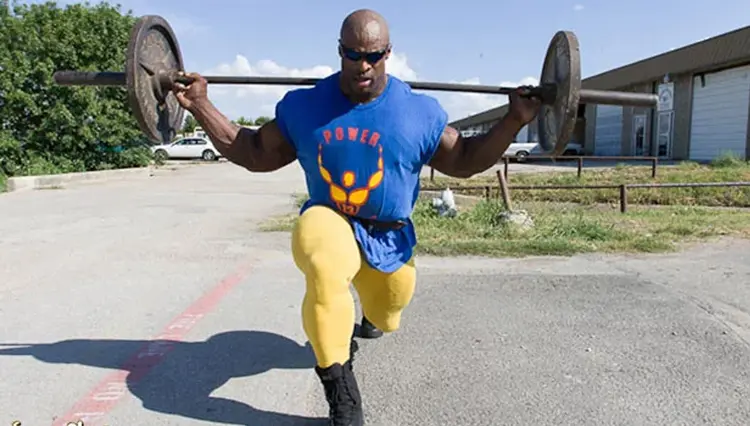
How to do it:
- Stand with your feet together, hands by your sides.
- Take a large step forward and into a split stance.
- Bend your legs and lower your rear knee down to within an inch of the floor. Keep your torso upright and your front knee behind your toes.
- Push off your front leg to return to the starting position. Do another rep with the same leg or swap legs and alternate as preferred.
Pro Tip: At the bottom of the lunge, consciously drive your front heel into the ground. This activates the glute of the front leg, maximizing its contribution to the movement.
| Difficulty | Beginner |
| Progression | Walking lunges, reverse lunges, Bulgarian split squats, jumping lunges |
| Regression | Static lunges, assisted lunges (holding onto a stable object) |
4. Leg presses
| Sets & Reps | 3 x 10-15 (Hypertrophy) or 3 x 6-8 (Strength) |
| Equipment Needed | Leg press machine |
| Target Muscles | Quadriceps, glutes, hamstrings |
The leg press uses many of the same muscles as squats and lunges, but because it’s a machine exercise, it’s much easier to learn.
With no weights to balance, you are free to focus entirely on pushing your muscles to the limit. Leg press machines vary from gym to gym, so make sure you ask a member of staff if you are new to this type of exercise.
Saini highlights that the leg press allows for a similar training stimulus as barbell back squats but with less stress on the spine.

How to do it:
- Lie on the machine and place your feet on the footplate, somewhere between shoulder to hip-width apart. Extend your legs and flip the safety bars out of the away.
- Keep your weight on your heels, bend your legs, and lower the weight as far as you can without rounding your lower back.
- Push the weight back up and repeat.
Pro Tip: Experiment with different foot placements on the platform to target different areas of your quads and glutes.
| Difficulty | Beginner |
| Progression | Single-leg leg press, increase weight/reps |
| Regression | Partial range of motion leg press |
Best Compound Movements for Upper Body Strength
Compound exercises are either pulling or pushing movements. Pulling exercises involve your back and biceps while pushing exercises involve your shoulders and/or chest, and triceps. You should be able to work all of your upper body muscles using just four compound exercises. Here are four of the best compound upper body exercises.
1. Bench press
| Sets & Reps | 3 x 8-12 (Hypertrophy) or 5 x 3-5 (Strength) |
| Equipment Needed | Barbell, bench press |
| Target Muscles | Pectoralis major, anterior deltoids, triceps |
The bench press is a classic test of upper body strength, and also a superb chest developer. It’s another powerlifting competition exercise and one of the most recognizable strength training exercises around.
The bench press is a simple, effective way to build upper body strength and muscle mass, says Saini.
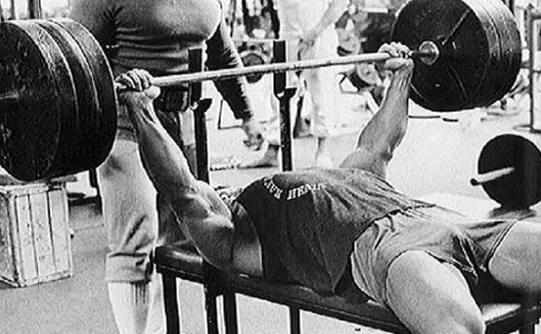
How to do it:
- Lie on the bench press, so your eyes are directly under the bar. Reach up and grab the bar with a slightly wider than shoulder-width, overhand grip. Plant your feet firmly on the floor, so your shins are vertical. Press your upper back into the bench and pull your shoulders down and back. Lift your chest up toward the ceiling.
- Unrack the bar and hold it directly over your chest.
- Bend your arms and lower the bar to lightly touch the highest part of your chest. Do not move your head or your feet. Tuck your elbows slightly into your sides as the bar nears your chest.
- Drive the weight back up to arms’ length, stopping just short of fully locking your elbows.
Pro Tip: Focus on bending the bar as you lower it to your chest. This engages the lats and triceps, creating a more stable base and potentially increasing your lift.
| Difficulty | Intermediate |
| Progression | Incline bench press, decline bench press, dumbbell bench press |
| Regression | Push-ups, incline dumbbell press |
2. Standing shoulder press
| Sets & Reps | 3 x 8-12 (Hypertrophy) or 3 x 6-8 (Strength) |
| Equipment Needed | Dumbbells or barbell |
| Target Muscles | Deltoids (all heads), triceps |
This deltoid and triceps exercise is a true test of upper-body pressing strength. With no bench to support you, you’ll need a strong core, stable legs, and good balance to complete it successfully, especially with heavy weights. Those factors make this exercise especially satisfying and productive.
Saini explains that the standing shoulder press is a great exercise for developing shoulder strength and stability. It also engages the core, making it a true full-body movement.
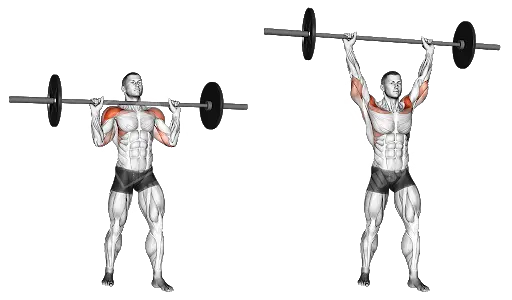
How to do it:
- With a barbell in a shoulder-high squat rack, hold the bar with an overhand, shoulder-width grip. Hold it across your shoulders, so your elbows are directly below or slightly in front of your hands. Lift your chest, pull your shoulders down and back, and brace your abs.
- Lift the bar out of the rack and take 1-2 small steps back. Stand with your knees slightly bent but rigid.
- Without bending your legs, press the bar up and overhead. Do not fully lock your elbows.
- Lower the bar back down to your shoulders and repeat.
Pro Tip: During the press, actively shrug your shoulders up towards your ears. This engages the upper traps and can help you lock out the weight at the top.
Level Up Your Fitness: Join our 💪 strong community in Fitness Volt Newsletter. Get daily inspiration, expert-backed workouts, nutrition tips, the latest in strength sports, and the support you need to reach your goals. Subscribe for free!
| Difficulty | Intermediate |
| Progression | Seated shoulder press, Arnold press, push press |
| Regression | Half-kneeling shoulder press, seated dumbbell shoulder press |
3. Bent-over rows
| Sets & Reps | 3 x 8-12 (Hypertrophy) or 3 x 6-8 (Strength) |
| Equipment Needed | Barbell or dumbbells |
| Target Muscles | Lats, rhomboids, traps, rear deltoids |
Bent over rows work the lats. They also involve your legs, glutes, and lower back, which have to work hard to keep your body stable.
You’ll also feel this exercise in your biceps. Bent-over rows can be hard on your lumbar spine, so use light weights until you have mastered it.
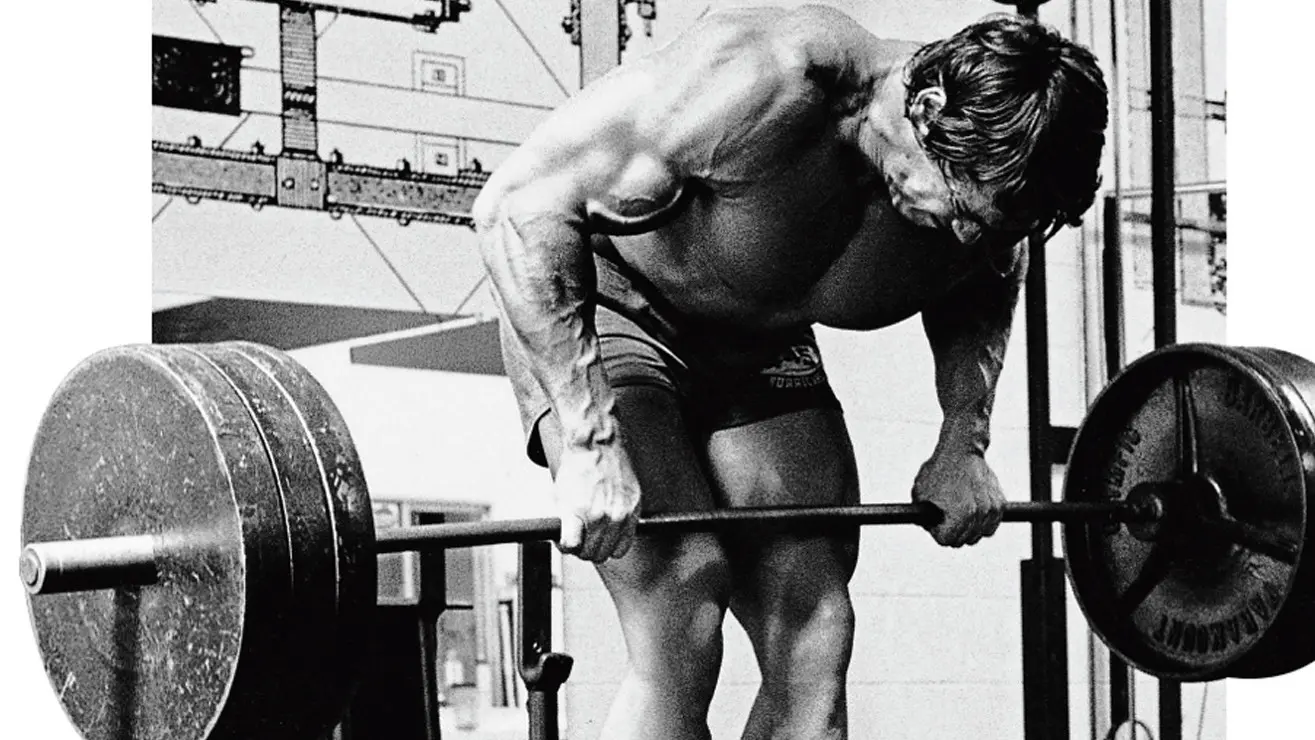
How to do it:
- Hold a barbell with an underhand, hip-width grip. Bend your knees slightly, but then keep them rigid.
- Lean forward until your torso is inclined to between 45 and 90 degrees. Let your arms hang down from your shoulders. Pull your shoulders down and back. Keep your head in line with the rest of your body. Brace your abs and make sure your lower back is slightly arched.
- Without jerking your back or using your legs, bend your arms and pull the bar into your abdomen. Lower the weight to arms’ length and repeat.
Pro Tip: Instead of just pulling the weight to your chest, focus on pulling your elbows back. This emphasizes scapular retraction and more effectively targets the lats.
| Difficulty | Intermediate |
| Progression | Pendlay rows, single-arm dumbbell rows, T-bar rows |
| Regression | Seated cable rows, inverted rows (bodyweight rows under a bar/table) |
4. Pull-ups and chin-ups
| Sets & Reps | 3 x to failure (Hypertrophy and Strength) |
| Equipment Needed | Pull-up bar |
| Target Muscles | Lats, biceps brachii, traps |
Pull-ups and their close relative chin-ups work your lats and biceps. Pull-ups involve using a wider-than-shoulder-width, overhand grip, while chin-ups use an underhand, shoulder-width grip. These variations are interchangeable, so use them both in your training.
These exercises help build immense upper body pulling strength and are a true test of relative strength, highlights Saini.

How to do it:
- Reach up and grab your bar with an overhand or underhand grip. Hang with your arms straight, and your shoulders pulled down and back.
- Brace your abs and lift your chest up toward the bar.
- Without swinging or kicking, bend your arms and pull your chin up and over the bar. Smoothly extend your arm, and, without relaxing your shoulders, repeat.
Pro Tip: Engage your core and glutes at the bottom of each rep to avoid swinging.
| Difficulty | Advanced |
| Progression | Weighted pull-ups/chin-ups, muscle-ups, L-sit pull-ups |
| Regression | Assisted pull-ups/chin-ups (with machine or bands), negative pull-ups/chin-ups |
Best Full-Body Compound Movements
While no exercise actually uses every single muscle group in your body at the same time, the following ones come very close. They involve your upper body and your lower body, which means they use multiple muscle groups and are a good way to train when you are short of time or want to build functional strength.
1. Power cleans
| Sets & Reps | 3 x 3-5 (Strength focus) |
| Equipment Needed | Barbell |
| Target Muscles | Full body (emphasis on posterior chain) |
Power cleans are a simplified version of the clean and press, which is an Olympic weightlifting exercise. As the name suggests, it’s useful for building power, which is your ability to generate force quickly.
Power is an integral part of most sports, and having more of it means you’ll be able to run faster, jump higher, and kick, punch, and throw harder.
“The power clean is a powerful Olympic lift that requires coordination and explosiveness,” Saini says. It’s an excellent exercise for developing athleticism and power.

How to do it:
- Place a barbell on the floor and stand with your toes beneath it. Squat down and grab it with an overhand, shoulder-width grip. Straighten your arms, drop your hips, lift your chest, and brace your core. Look straight ahead.
- Without rounding your lower back or bending your arms, stand up explosively, rising up onto your toes as you do so.
- As the bar passes your thighs, pull with your arms to keep it moving upward.
- Drop onto your heels, drive your elbows forward, and catch the bar across the front of your shoulders. Bend your knees slightly to absorb some of the impact. Stand up straight to complete the lift.
- Roll the bar forward and off your shoulders, and then lower it to your thighs.
- Do a reverse deadlift to lower it back to the floor.
- Reset your position and repeat.
Pro Tip: Aggressively jump and shrug as you extend your hips. This explosive movement generates momentum and helps you elevate the bar to the catch position.
| Difficulty | Advanced |
| Progression | Hang cleans, clean and jerk |
| Regression | Kettlebell swings, deadlifts |
2. Burpees
| Sets & Reps | 3 x as many reps as possible (AMRAP) |
| Equipment Needed | Bodyweight |
| Target Muscles | Full body (cardiovascular focus) |
This full-body compound exercise is a great cardio and conditioning move. In just a couple of yards of space, you can work your upper and lower body and your heart and lungs too. It’s ideal for circuit training and HIIT workouts.
Saini explains that burpees are a full-body conditioning exercise that can be used to improve cardiovascular fitness and muscular endurance.
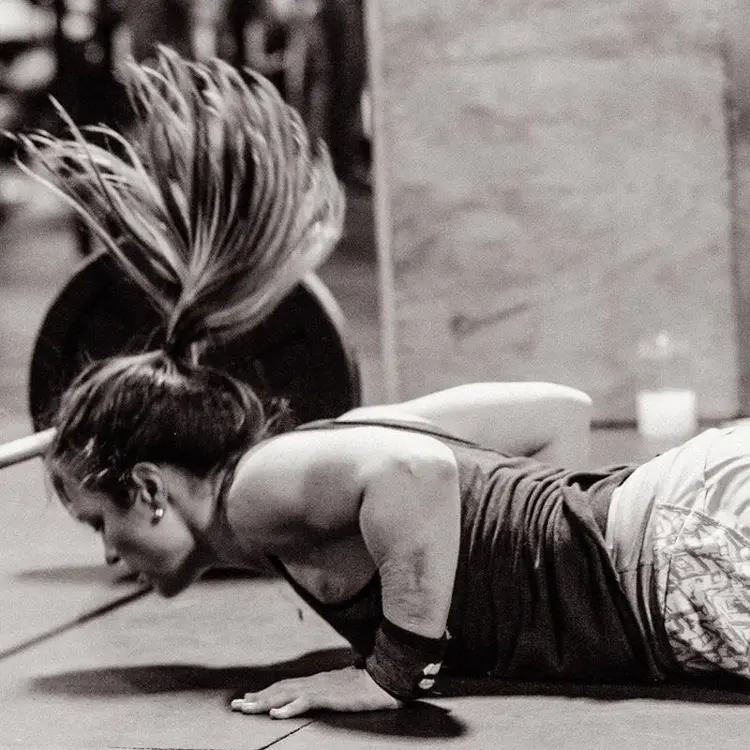
How to do it:
- Stand with your feet together and your hands by your sides.
- Squat down and place your hands on the floor. Jump your feet out and back into the push-up position.
- Bend your arms and do one full push-up.
- Jump your feet back up and into your hands.
- Leap up into the air.
- Land on slightly bent knees and repeat.
Pro Tip: During the push-up portion, maintain a hollow body position to protect your spine. This means engaging your core and glutes to keep your body in a straight line from head to heels.
| Difficulty | Beginner |
| Progression | Burpees with a push-up, burpees over an object, burpee box jumps |
| Regression | Squat thrusts, step-ups |
3. Kettlebell swings
| Sets & Reps | 3 x 15-20 (Hypertrophy) or 3 x 10-12 (Strength) |
| Equipment Needed | Kettlebell |
| Target Muscles | Glutes, hamstrings, core |
This full-body exercise is an excellent alternative to power cleans. It’s straightforward to learn, but no less effective. As well as being a good power exercise, kettlebell swings are also an effective conditioning and cardio move.
Saini underlines that kettlebell swings improve hip hinge mechanics and are a great way to burn calories.
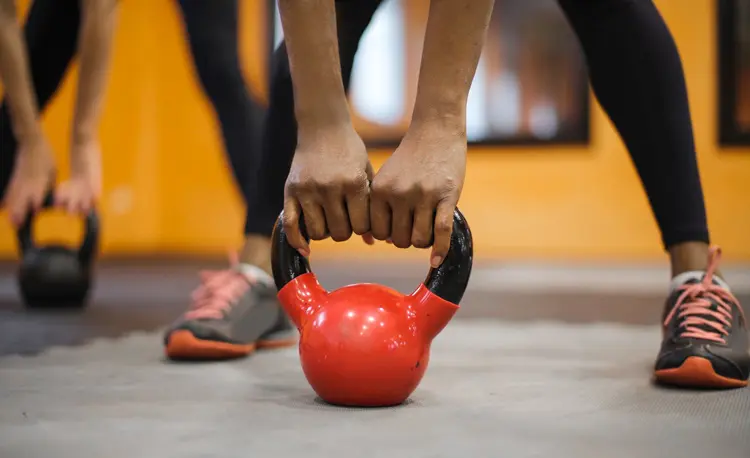
How to do it:
- Hold a kettlebell in front of your hips. Stand with your feet about shoulder-width apart. Bend your knees slightly.
- Keeping your arms straight, push your butt back, lean forward, and lower the weight down to your knees.
- Drive your hips forward and use this momentum to swing the weight forward and up to about shoulder height.
- Swing your kettlebell back down and repeat.
Pro Tip: The power of the swing should come from the hips, not the arms.
| Difficulty | Beginner |
| Progression | Single-arm kettlebell swings, American kettlebell swings |
| Regression | Deadlifts with lighter weight, kettlebell deadlifts |
4. Thrusters
| Sets & Reps | 3 x 8-12 (Hypertrophy) or 3 x 5-6 (Strength) |
| Equipment Needed | Barbell or dumbbells |
| Target Muscles | Quadriceps, glutes, shoulders, triceps |
Thrusters combine front squats with an overhead press to work your upper and lower body. When done with heavy weights, this is a useful power and strength exercise. When done for high reps with light weights, it’s a tough conditioning exercise.
Saini adds that thrusters are a metabolically demanding exercise that combines a front squat with an overhead press, which can help build strength and endurance.
How to do it:
- Hold a barbell across the front of your shoulder with your elbows directly below your hands. Stand with your feet about shoulder-width apart. Brace your abs and look straight ahead.
- Bend your knees and squat down until your thighs are roughly parallel to the floor.
- Stand up explosively and use this momentum to help you push the bar up and over your head.
- Lower the bar back to your shoulders and repeat.
Pro Tip: Use the momentum from the squat to help you press the weight overhead.
| Difficulty | Intermediate |
| Progression | Cluster thrusters, single-arm dumbbell thrusters |
| Regression | Front squats, overhead press (separately), goblet squats |
Best Compound Exercise-Focused For Building Strength and Muscle
Perform this workout at least twice weekly for the best results:
| Exercise | Sets | Reps | Rest (Minutes) |
| Squats | 3 | 8-12 | 1-2 |
| Bench Press | 3 | 8-12 | 1-2 |
| Bent-Over Rows | 3 | 8-12 | 1-2 |
| Lunges (per leg) | 3 | 10-15 | 1 |
| Kettlebell Swings | 3 | 15-20 | 1 |
Important Compound Exercise Training Tips
Get the most from any compound exercise with these helpful tips.
Match your reps and weight to your goals
There is an ideal rep and weight scheme to match your training goal. Apply the following parameters to your workout to make it as productive as possible.
- Strength/power – 1-5 reps per set using 85% or more of your one-repetition maximum (1RM).
- Hypertrophy – 6-12 reps per set using 67-85% of your 1RM.
- Muscular endurance – 13-20 reps per set using 50-67% of your 1RM.
The lower your reps and the heavier the weight, the longer you should rest between sets. For strength and power, rest 3-5 minutes between sets. In contrast, 60-90 seconds is about right for hypertrophy. For endurance, take very short rests, typically 30-60 seconds.
Warm-up properly before working out
Compound exercises involve lots of muscles and joints working together. They can be tough, putting a lot of stress on your body, especially if you are using heavy weights. Take it easy on your joints by warming up thoroughly before your workout. Do a few minutes of easy cardio, followed by dynamic stretches and joint mobility exercises for the body part(s) you are about to train. Finish your warm-up with 1-3 light sets of your chosen compound exercises.
Technique before weight
While compound exercises can allow you to lift big weights, you should make sure your technique is sound before you try to go too heavy. With so many muscles and joints to control, there is a lot that could go wrong during things like squats, bent-over rows, and power cleans. Mistakes could lead to injury, especially if you are using heavy weights. Get the technique right before trying to lift maximal loads.
Experiment with different grips
For upper body exercises, different grips can change the feel and effect of your workout. In many cases, you can use several different hand positions for each movement. Experiment with different hand positions to keep your workouts fresh, interesting, and productive.
Wrapping up
Where there is nothing inherently wrong with isolation exercises, they are not the most efficient use of your training time and energy. After all, if you wanted to train your whole body using isolation exercises, you’d need to include ten or more moves to work each of your major muscles.
In contrast, you could conceivably train your whole body using just three or four compound exercises, more than halving the time you need to spend working out.
Build your workouts around compound exercises, and then use isolation exercises to finish off the target muscle group. That way you can enjoy all the benefits of both types of training.




